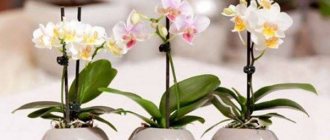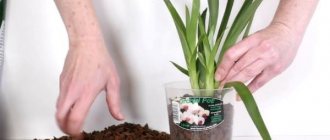Exotic orchids are sold in almost any gardening store. At first sight they attract with their unusual appearance and beautiful colors. But it often happens that some time after purchase the orchid dies. This is due to the fact that a resident of the tropics needs special care, which novice gardeners cannot always provide.
First of all, you need to know how often you should water your home orchid, how to do it correctly and what kind of water to use. It is due to improper watering that the flower most often dies, so we decided to devote a separate article to this procedure.
- Dive
Instructions on how often to water an orchid
Basic care for an orchid comes down to timely watering. Every experienced gardener knows that its frequency and intensity depend not only on the growing season, but also on the season (Figure 1).
When the plant is in the active phase of development, growing green mass or blooming, the application of liquid should be more intense. During the dormant period, watering is reduced, but the substrate should not be allowed to dry out completely or the roots will not dry out.
Figure 1. Frequency of application of moisture depends on the season
So that you do not have any difficulties with watering your orchid throughout the year, we will look at the features of this procedure for each season in more detail.
in spring
There are no clear instructions on the frequency of applying liquid in the spring. The orchid is watered depending on the degree of humidity of the substrate and the temperature in the room. In general, we can say that it is better to add moisture at this time of year rarely, but in large quantities.
It is important to add water in such a volume that the roots can absorb it all. If the root system is constantly in water, it will begin to rot and over time the plant will die.
Note: Spring watering should be consistent with the orchid's natural growing environment. These flowers grow on tropical trees in climates where heavy rainfall alternates with heat.
At home, you also need to try to recreate such conditions. In other words, moisture is added to the pot only after the substrate is completely dry. However, if you have just moved the plant to a new pot, do not immediately fill it with water. After transplantation, orchids are watered only a few days later so that the plant has time to adapt to the new habitat and container.
In summer
In summer, orchids begin their flowering period. At this time, the plant is in great need of moisture. Without frequent and abundant watering, the plant will simply drop its buds. Accordingly, at this time of year, liquid is added approximately once a week, and if the weather is dry, then once every four days (Figure 2).
Figure 2. In summer, the crop blooms and is in great need of moisture
It is better to take melt or rain water for watering orchids. But, if you do not have such an opportunity, you can also use settled water supply. The main thing is that it is not cold, as this can lead to an outbreak of fungal diseases. The liquid should be at room temperature, and then the exotic flower will receive all the necessary substances for active flowering.
in winter
If in summer an orchid loves abundant and frequent watering, which is necessary for flowering, then in winter this crop begins a dormant period. At this time, you should not frequently water or feed the flower (Figure 3).
Figure 3. In winter, exotic plants enter a period of rest and watering is carried out no more than twice a month.
The fact is that the abundance and duration of flowering in the new season will depend on proper rest during the dormant period. Given this feature, you should first wait until the substrate is almost completely dry, and only then water it. On average, the procedure is carried out once every two weeks. In this case, the volume of introduced moisture should still be large.
Some tips for beginners
- Use clay pots to plant orchids They allow air to pass through well; make sure that there is no glaze on the vessels - it does not allow air to pass through. In plastic pots, stagnant moisture can form in the ]substrate[/anchor];
- If possible, use rainwater collected away from the city. This water should be stored in a cool, dark place;
- To protect against rotting of the substrate, add potassium permanganate to the water ;
- Wait until the substrate dries completely between moistening the soil.
Water and solutions for watering orchids
You can water an indoor orchid not only with regular water, but also with various solutions and infusions that will help improve the health of the crop and make its flowering more abundant and longer.
Note: Succinic acid is most often used for irrigation. It helps the leaves remain elastic and helps the plant better tolerate changes in humidity and high temperatures.
There are other recipes for watering orchids with various infusions and preparations:
- Garlic solution helps saturate the substrate with nutrients and vitamins. However, it should be remembered that you should not add this substance to the soil too often, since an overabundance of nutrients will cause the orchid to hurt.
- An indoor flower can also be watered with hydrogen peroxide, ammonia and potassium permanganate. All these drugs serve as excellent prevention of the spread of pests and diseases. To do this, prepare a solution with a minimum concentration of manganese or another substance, and watering with these preparations is carried out no more than once a week. If the solution is too concentrated or applied frequently, the plant may quickly die.
- Irrigation with iodine or yeast is used for a similar purpose. As in the previous case, you need to use only a solution of weak concentration.
Remember that any preparation for irrigation must be weak. The roots of the orchid are not in the ground, but on the surface of the substrate, and a high concentration solution can cause serious burns or oversaturation with nutrients (Figure 4).
Figure 4. For irrigation, you can use not only ordinary water, but also solutions of conventional preparations
As a result, you will achieve the absolutely opposite effect: from such watering, the orchid will first begin to hurt, and then may even die.
Care
Proper care of orchids during flowering requires increased attention and painstaking work, otherwise the flower will not delight you with flowers for long. Each aspect of proper care is closely related to watering.
If the orchid blooms poorly or has stopped blooming, then read the material where we talk in detail about how to make it bloom at home, as well as about the correct pruning of the orchid after flowering.
Temperature and lighting . Orchids do not like direct sunlight, because it is harmful to the leaves and the entire plant as a whole. It is better to place the orchid under diffused light or organize shading. The temperature range is selected average. That is, the maximum daytime temperatures are not higher than 28 degrees, and the minimum night temperatures are not lower than 18.
Important! Incorrectly selected temperature and light conditions in combination with any watering lead to diseases of the roots and leaves. This always has a bad effect on the color period and its duration.
Soil and container . They play an important role in watering the flower at any stage of plant development. Choose a well-ground substrate that contains only those ingredients that have good drainage capabilities. The flower pot must be of the appropriate size and transparent, which will provide visual control of the level of moisture in the soil and good aeration of the roots.
Important! Poor soil quality and unsuitable containers cause serious damage to the flower. Any watering will be ineffective and harmful if these 2 components of proper care are not at a high level.
How often to water an orchid with succinic acid
Succinic acid is used for watering orchids more often than other means. This is due to the fact that it contains components that are indispensable for exotics. Under their influence, the quality of flower leaves and its resistance to adverse environmental factors improves.
In order for watering orchids with succinic acid to be beneficial, it must be done correctly. First, dilute the product in water, and then add it to the substrate in the usual way. If you accidentally poured more liquid, wait until it drains into the pan and drain it.
It is important that succinic acid for watering an exotic flower can only be used in spring and summer, when the orchid is growing intensively. It is not recommended to use this product in winter, since such replenishment will not allow the flower to rest properly.
Spraying the plant
Spraying is also watering, which can be used as an alternative method of moistening a flower. In nature, the plant absorbs water not only through its rhizome, but also through its leaves.
If the air in the room is dry, it contributes to the rapid evaporation of moisture from the soil, and moisture loss also occurs through the leaves of the orchid.
Do not forget that the flower comes from the tropics, so its natural habitat is characterized by high humidity. If for some reason you don’t want to spray the orchid leaves, then spray water around the plant.
Spraying nuances:
- You need to make sure that water gets to the soil.
- Do not allow water to accumulate in the axils between the stem and leaves of the orchid.
- If there is excess liquid on the leaves, it is removed with cotton swabs or a cloth made of natural material.
Methods of watering orchids
There are quite a lot of methods for watering orchids in a pot, and they can be used both for the usual procedure and for watering with phytosporin or other means.
We will look at each of the methods so that you can choose the appropriate one or equip the pot with automatic watering if you do not have the ability to constantly monitor the moisture level of the substrate.
Dive
This method, due to its simplicity and effectiveness, is considered the most popular. If you are going to constantly saturate the aerial roots of the orchid with moisture in this way, it is better to immediately buy a special pot without drainage holes in the bottom (Figure 5).
Note: Its diameter should be slightly larger than the container in which the flower grows. If there is no special pot, you can use any other tank.
So, caring for exotics in this way is very simple. The selected container is lightly filled with water, and then the orchid pot is immersed in it. If there is not enough water, you can add it a little. It is important to ensure that the liquid does not overflow. Ideally, it should be 1-2 cm short of the top edge of the container.
Figure 5. Immersion is the best way to saturate the substrate with moisture.
To properly water an orchid, it is enough to leave it in such a bath for 10-15 minutes. During this time, a sufficient amount of moisture will enter the expanded clay and the substrate. When you notice that moisture has appeared on the top layer of soil, you can remove the pot from the water and allow the excess liquid to drain. By the way, during such watering it is convenient to trim damaged roots and fertilize: just dissolve fertilizers in water.
Overhead watering with a watering can and warm shower
Top watering of orchids with clean water or liquid with garlic through a watering can is also practiced quite often. However, for the addition of moisture to be beneficial, extreme care must be taken. The main thing is that water does not get into the axils of the leaves, since the accumulation of liquid can lead to rotting of the plate.
Figure 6. Warm shower imitates natural precipitation
It is better to pour water at the root from a watering can with a thin long spout. It should be poured until liquid begins to seep through the drainage holes. Then take a break for a few minutes and repeat the procedure 3-4 more times. The liquid that has flowed into the pan must be drained.
Quite often they practice watering orchids with running water - the so-called hot shower. In fact, the water should not be hot, but only slightly warm to simulate tropical rain (Figure 6).
Note: This is the only method in which you can use regular tap water, but only if watering is not done daily, but from time to time.
There are many advantages to this method. Firstly, the substrate is filled with the required amount of moisture. Secondly, dust, bacteria and pest larvae are washed off from the leaves.
For a shower to benefit your orchid, follow these recommendations:
- Use warm, not cold water. In some cases, it is allowed to use liquid with a temperature of 40-50 degrees. You can also dilute fertilizers in it.
- The orchid is left in the shower until the substrate is completely saturated with moisture.
- Next, turn off the water and allow the excess liquid to drain into the pan.
- After this, you need to leave the orchid in a shaded place for 40 minutes, and then wipe the leaves with a clean napkin. The main thing is to ensure that water does not remain in the axils of the leaves, as this can cause them to begin to rot.
When the orchid has rested from the procedure, it can be moved to a permanent place.
Spraying the roots
This method is suitable only for experienced gardeners, since not everyone decides to grow an orchid in the open. It does not involve the use of a substrate for roots that simply hang in the air (Figure 7).
Figure 7. Only plants with an open root system are watered by spraying.
To saturate the plant with moisture after pruning or during flowering in the spring, you need to use a spray bottle with very small holes. With its help, hanging roots are irrigated with water. Here it is important to clearly calculate the amount of moisture so that the roots receive a sufficient amount of moisture, but are not oversaturated with it.
Important Details
As for the time of watering, it is best to water a blooming orchid in the morning or, in extreme cases, before lunch.
Another important point is assessing the timing of watering. If you usually need to wait until the roots become silvery, the substrate is completely dry, and there is no condensation on the pot, then during coloring you should not wait for all these signs. That is, if you observe slightly green roots in the pot below, and a small remaining condensation on the walls of the pot, then this indicates that watering can already be carried out. This is the difference between watering an orchid during flowering and dormancy.
How often to water an orchid during and before flowering
When a plant throws out a peduncle or buds bloom on it, you need to be especially careful about watering. At this time, the orchid needs moisture most, and its lack can lead to a delay or complete absence of flowering.
You can determine the need for watering visually or by the following signs:
- If the pot becomes lighter in weight, immediately add moisture. A wet substrate is denser and heavier, and you will definitely feel the difference in weight before and after watering.
- Try raking out some of the substrate with your finger. This will help determine its moisture level.
- You can simply stick a wooden toothpick into the soil. If it remains dry, then your orchid needs watering.
- The color of the substrate and roots also very clearly indicate the need for watering. Wet soil is always darker than dry soil, and dry flower roots become light gray rather than green.
You can see what proper watering of an orchid looks like in practice in the video.
Possible problems
Stagnation of moisture is extremely destructive for all types of phalaenopsis . Root rotting will lead to stunted growth, disease and, in extreme cases, death of the flower.
Systematic underwatering of epiphytes leads to weakening of the plant ; such a specimen will not bloom. Stopping moisture while the buds are setting threatens to cause them to drop.
Underwatering leads to wilting and dropping of buds.











